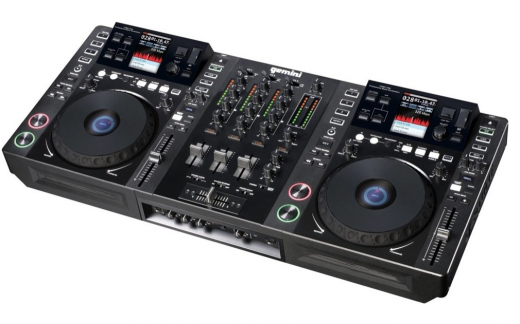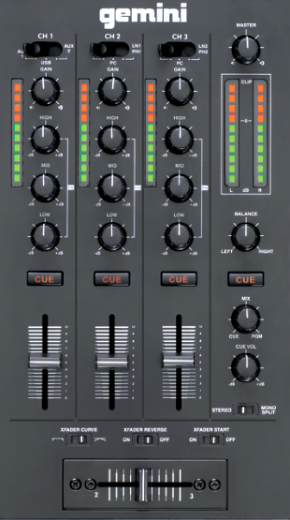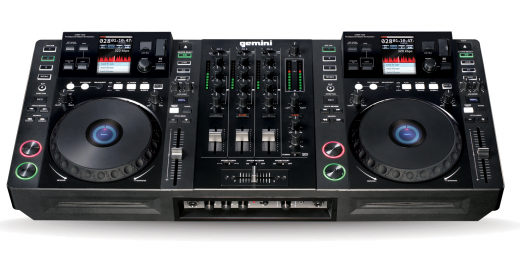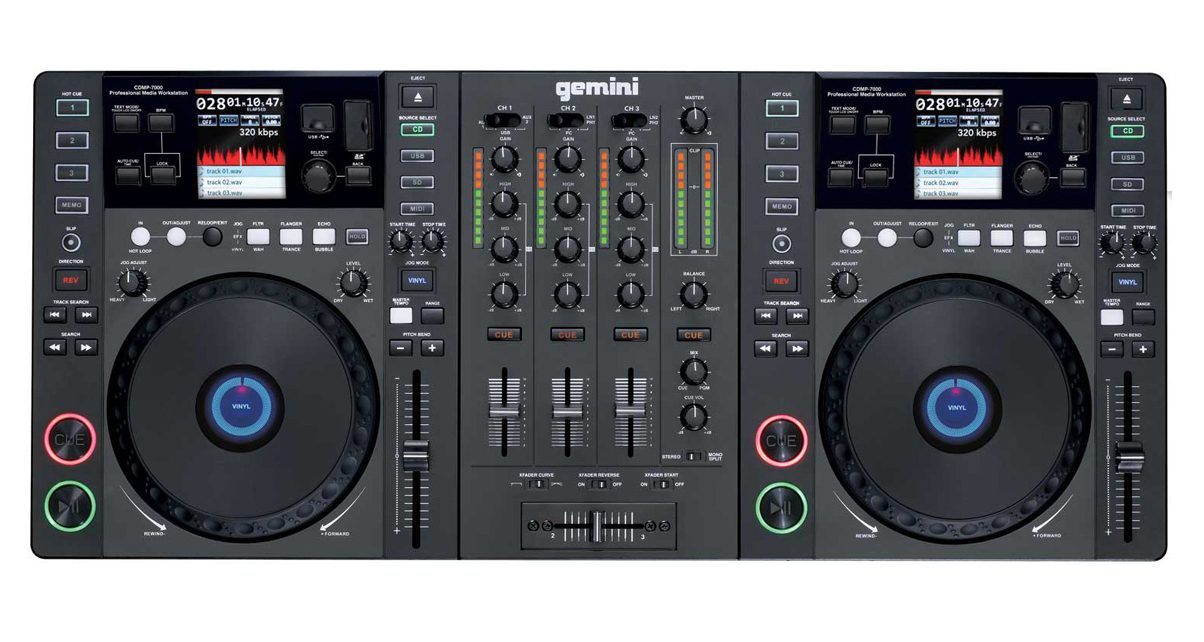The Lowdown
The Gemini CDMP-7000 Professional Media Workstation is a substantially sized two-decks-and-a-mixer controller containing two fully featured media players (CDs, USB, SD card and Midi control), plus built-in audio interfaces, and a three-channel analogue mixer. The CDMP-7000 should appeal the most to mobile DJs, to CD timecode DJs who want a decently priced practice system for home, and to DJs coming from analogue who want something that feels more familiar than modern 100% digital DJ controllers. Just be aware it has sadly appeared to suffer from more than its share of reliability issues.
Don’t have our latest DJ gear guide? Click here to grab your free copy
Video Review
First Impressions / Setting up

The unit is big, bold and workmanlike, with a metal chassis, and hardwearing black plastic casing elsewhere. It feels industrial rather than “home”, and style-wise bears a lot more in common with pro DJ booth equipment (read: Pioneer) than most consumer DJ controllers. Its appearance is more or less that of two CDJ media players and a small mixer, stuck together. Not surprising, because apart from the case joining it all up and the shared power supply, that’s exactly what it is.

The CDJ media players are to all intents and purpose exactly the same as the Gemini CDJ-700s (read our Gemini CDJ-700 review here) – good value CDJ-style players that can handle all kinds of media as well as control Midi software (Traktor, VirtualDJ etc.) and act as audio interfaces for that software too. Indeed the only control that isn’t Midi-mappable is the jogwheel adjust, which is a purely mechanical resistance knob.
If you want to know more about them, go and read the CDJ-700 review; we cover what they’re like to use a little further down in this review, but suffice to say here that we think they’re great if you want a more authentic “club feel” in your home gear, because they’re so similar to Pioneer CDJs. The colour touchscreen is cute but ultimately a bit gimmicky, and the effects are so-so, but overall as standalone players we liked them, and in their incarnation as part of this system, they’re generously featured and work well.
The middle section of the CDMP-7000 is the three-channel analogue mixer. Analogue means that it is not digital in any way – it takes audio, not digital, inputs from the CDJs, from external sources or from your computer (because the CDJ audio interfaces handle the computer sound). The mixer is also not Midi enabled, so it can’t control mixer functions on your DJ software. That means you use it with DJ software in “external” mode, the software acting as library and decks, but the Gemini hardware acting as your mixer.
Learn to DJ with Digital DJ Tips: The Complete DJ Course
This method of DJing has its pros and cons, but it works; DVS users DJ in this way by default, and many DJs prefer analogue mixers for the way they sound and the ease of mixing in external sources. This one has a twist in its tail: A USB out for recording your mix straight to PC to save needless digital to analogue and back to digital conversion.
There are two microphone inputs: A combi mic on the back and a 1/4″ TRS on the front, where you’ll find a full gamut of mic controls – on/off/talkover button, volume, and two-band EQ. Also on the front on a recessed control panel is a booth monitor volume knob and a pair of headphones sockets (1/8″ and 1/4″).

The mixer itself is three channel, and is equipped with the feature set of a basic club mixer rather than that of your average DJ controller equivalent. That means that as well as the full expected range of inputs and outputs (the aformentioned mics, plus dual line/phono, two aux ins, and master/booth/record outs including XLR), it has additional welcome features.
These include proper, full VU monitoring (a meter per channel, plus stereo output metering); true mono split for the headphones; and both crossfader curve and reverse switches. An extra channel would have been nice to save cramming so much into the three-way channel matrix controls above each line, but overall, it’s got all you need for DJing with the unit in a wide variety of ways.
Setting up for software DJing involves installing your DJ software of choice (none is supplied) along with a mapping, then setting the Midi and audio configuration up correctly. This could trip you up if you’re not used to doing these things, because these kinds of things still trip up beginners even after 10 years of DJ controllers being out there, but also because this being two separate CDJs, you need to configure them separately. However, there are reasonably clear guides for both Traktor and VirtualDJ on the Gemini website. With VirtualDJ you have to copy a few files across (device and mapping), with Traktor you import the .tsi from the software’s config screen.
The unit is sold as “class compliant” which means it shouldn’t need audio drivers, but the instructions tell you to install the Gemini audio driver for PC, which makes sense as the point of custom drivers is to get performance above what’s possible with Windows drivers. No drivers needed for Mac, of course.
In Use
DJing with software
First we tested the unit with Traktor and VirtualDJ, in order to see how well the jogwheels work and how responsive the controls are for Midi.
With VirtualDJ, especially with the HID mapping which is superior to the also-supplied Midi mapping, jogwheel performance was pretty good, and overall response from the controls was tight. There was also the added advantage of track info on the CDJ screens, something you don’t get with Traktor.
With Traktor, jogwheel performance was also good but not excellent – as it is for most controllers with Traktor apart from Traktor’s own and some HID-mapped high-end Pioneers. With both pieces of software, the jog performance is fine for cueing, but you wouldn’t want to scratch on it.

Apart from that, the Traktor mapping – like the VirtualDJ one – covers the transport basics well enough, but just be aware that as mentioned above, you don’t get to control the mixer in either or any DJ program, because the CDMP-7000s mixer is analogue and not Midi-enabled. Note that in Midi mode, effects are mapped to your software’s effects – you’re not using those built in to the CDMP-7000. Although in theory it’s perfectly possible to map the touchscreen to your software, but out of the box when you’re using Midi mode none of the mappings does this for you.
The pitch control, assuming your software is set to the lowest possible pitch range, easily manages 1/100th of a BPM control, which is very good for manual beatmatching – just as well, as there’s no sync button (although you could map it, or tap it on the computer screen if you wanted).
Using CDs/USB/SD card
It takes a few seconds to switch modes, but once you’ve switched successfully to CD mode, you get waveforms, track timings and a wealth of other information on the touchscreen. The browser search knob now switches from software control to let you navigate tracks on a CD, or (using button control too), navigate libraries on USB/SD card.
Also, now you get to use the built in FX, of which those that use jogwheel as a control are better than the “fixed” ones that don’t. You may find yourself using the filter and flanger, but the rest are take-it-or-leave-it. In particular I struggled to get any beatmatched goodness out of the echo. Again, just like with software, the pitch control is very good (not quite as good as software I didn’t think, achieving for me 1/50th of a BPM control) – but now you get much tighter jogwheel control than with software, as well as start/stop speed controls and a “slip” mode, just like on Pioneer, Denon and indeed now Traktor products. As CD decks, these are pretty good and they’re very cost effective in this package.
Switching from Midi to non-Midi in a set
It is possible to DJ a set using multiple sources, as you can chop and change as you wish. For instance, you could switch from Midi to CD, or play a track off a friend’s USB drive (or I guess even from a smartphone via USB in certain circumstance, although we didn’t check that), in addition to having your computer software plugged in.

The way this works is different in the two programs we tested it with, Traktor and VirtualDJ. With VirtualDJ, when you switch away from Midi on one of the CDJs, VirtualDJ keeps playing the track but “forgets” all your audio settings, reverting to using your computer’s internal sound card, which is a little annoying. It then doesn’t switch back to CDMP-7000 audio when you switch back to Midi on the CDJ, so you have to manually reconfigure it, which is even more annoying. You won’t want to be doing this in public.
With Traktor, as soon as you switch away from Midi, Traktor stops playing and informs you there’s no audio device connected, but when you switch back, after a few seconds everything takes up where you left off. This is preferable, though not perfect; from a user point of view, being able to switch smoothly and easily from one to the other and back again with everything still playing in the background would be best. However – and it’s a big however – you can have one deck on Midi and one on CD, USB etc. In this case, you do get that instant, smooth switch between the two. Better than nothing, for sure, but really you should think of this as a unit you DJ with software or USB/CD/SD card, but not all together in the same set, especially if you’re planning on using it with VirtualDJ.
Other ways to use the CDMP-7000
For this section of our CDMP-7000 review, we’ll look at how else the unit may be used. Indeed, the CDMP-7000 really comes into its own when you start to consider how flexible it is. This is something that equally is going to confuse people who aren’t sure what they’re buying – but assuming you’re potentially going to want some of this flexibility, it’s a strength, not a weakness. For instance:
- It has individual CD outs. That means you can use it with Traktor Scratch Pro or Serato Scratch Live as a DVS. Because it’s Midi, it can be a true hybrid unit, with Midi control over your software as well as transport control, and all the advantages of using timecode for truly tight scratching etc. If you use DVS in the clubs, this means the CDMP-7000 would make a great home unit on a budget
- It has true external inputs, meaning you can plug decks, other CDJs, other DJ controllers, MP3 players (one of the Aux inputs is an 1/8″ TRS) plus two microphones in for maximum flexibility. This would be great, therefore, for mobile DJs or indeed for this to be used as a “house” unit in a bar or similar where there are different DJs requiring different set-ups
- It has the ability to record straight to PC and monitor that recording back to the unit
- The CDJs have digital outs, so you can use them as high quality CDJs with another digital mixer if you like, bypassing the internal audio interface should you wish
Coupled with the fact that you can use one deck digitally and one analogue – meaning at the very least easy DJ changeovers from a CD/USB guy to a digital guy – and it becomes apparent that what the CDMP-7000 loses in ease of initial comprehension and understanding, it ultimately gains in flexibility.
Conclusion
This unit is “of a type” – and that “type” is a pair of CDJs and an analogue mixer in a single box. It’s important to think of it as such, because if you think you’re buying a full Midi controller with a Midi mixer, you’ll be misleading yourself.
As you may have gleaned from the list above, this actually needn’t be an issue. Indeed, many people prefer using software as a library/decks rather than the full shebang, and enjoy having an old-school analogue mixer sat in the centre, feeling not only that sometimes such mixers can sound better, but that they make more sense when your DJing involves a mixture of digital and non-digital sources.
DJ like a pro using ANY gear: The Complete DJ Course

The CDJ sections represent great value for the money, and have a lot of decent features. While not up there with the top Pioneer CDJs (no networking, only basic two-way HID and then only with VirtualDJ, no sharing of USB info from player to player etc), they do have slip mode; that true CDJ feel; reverse; and stop/start break, plus of course standards like looping and cues. And the colour display is nice, especially with its useful waveform (something sadly not available in DJ software modes). The mixer adds features that many DJs moving from analogue to digital (or indeed club DJs looking for a home controller) would otherwise miss – most notably all the right ins/outs plus excellent VU metering.
A word about sound quality. On a Mac, you have to use it in 44.1kHz/16-bit mode when you’re using VirtualDJ, a limitation that doesn’t present itself with Traktor or with PCs, where you can go up to 192kHz/24-bit. Nonetheless to my ears the sound card used in the CDMP-7000 sounded fine, and nothing about it suggested it wasn’t up to the job of what it’s designed to do – which is power parties in bars, lounges, mobile gigs and in home DJ set-ups.
Who it’s ideally suited to
The CDMP-7000 should appeal the most to mobile DJs; to CD timecode DJs who want a decently priced practice system for home; and to DJs coming from analogue who want something that feels more familiar than modern 100% digital DJ controllers. In all of these cases, it’s got a lot to offer.
But for home DJs with club aspirations, here’s the biggest bonus of this over a “normal” DJ controller: It’s an excellent bridge between home DJing and club. If you’re hoping to make this leap, at some point you’re going to have to learn to use CDJ-style gear, possibly without the computer even – but certainly without the sync button. This unit can help you with all of that. If you can get past setting it all up right (admittedly, not easy for beginners, and particualrly not so on this due to the added complexity of setting up two, not one, decks), you’ve got a DJ system that you can use pretty much the same way as any DJ controller – until you’re ready to make your “club transition”.
At that point, you can put your tunes on USB or CD, and make like you’re using CDJs in a real DJ booth. The differences are negligible (as it’s as close to club-standard Pioneer gear as you’re going to get without buying Pioneer gear), and you’d be far better prepared for a club DJ set training yourself this way at home on a CDMP-7000 than on either a normal DJ controller, or just about any other all-in-one (ie CD/USB/Midi) DJ controller out there.
The only caveat would be quality, you’re not getting true pro, club-standard gear here, and we have heard lots of reports of issues, returns and so on with this unit – far more than with most other DJ gear, probably due to the price and the fact that it’s “all in one” (so there’s simply more to go wrong). So make sure you are comfortable with the servicing arrangements offered to you before taking the plunge.
Want help choosing gear? Grab your free PDF: The Digital DJ Gear Buyer’s Guide




